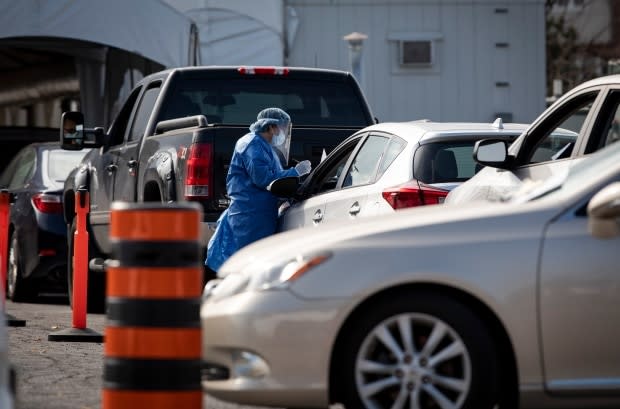Case counts alone don't paint a reliable picture of COVID-19 in Ontario, experts warn

As COVID-19 case counts in Ontario surge to never before seen levels, some experts warn that the public should not look to cases alone as the sole indicator of the virus's spread, thanks in part to recent upheaval in provincial testing guidelines.
Instead, they say, Ontarians should consider a variety of statistics, including deaths, hospitalizations and positivity rates to get a clearer picture of what's happening — and all of those indicators point to worrying trends right now.
At a news conference Friday, Dr. Adalsteinn Brown, who is advising the province on its pandemic response, illustratted a host of "very clear, accelerating trends" in places like Toronto, Peel and Ottawa. Ontario is now imposing stricter measures in those regions to clamp down on the situation, as a record 939 new cases were recorded Friday.
"The curve continues to increase in terms of its steepness," Brown told reporters.
So what should people who aren't scientists do when trying to make sense of a sea of COVID-19 data? Ultimately, people need to look at a combination of things, said Ashleigh Tuite, an epidemiologist at the University of Toronto's Dalla Lana School of Public Health.
"There's not a perfect, single metric that's going to give you a perfect sense of what's happening in terms of transmission," she told CBC News.
"We certainly shouldn't be looking at the reported case numbers alone. They've become very difficult to interpret."
Through the summer, Ontario was offering asymptomatic testing to anyone who wanted it at assessment centres. But as lines surged and the testing backlog grew through the fall, the province switched to solely symptomatic, appointment-only testing, which has changed the makeup of who is being screened.
That, in turn, influenced the results. That testing backlog surged to over 90,000 last week, and as of Friday stood at just over 58,000.
"The official case count is notoriously unreliable," said epidemiologist Dr. Tim Sly, professor emeritus at Ryerson University. Sly told CBC News case counts also can't be taken as gospel because a large number of people can be asymptomatic, but still infected and contagious.
WATCH| Ford's changing message about COVID-19 in Ontario:
Still, Sly said, case counts do give the public a general sense of whether infection numbers are going up or down. "It's also a good snapshot of where we're finding the infections," he said.
Brown said Friday the province is seeing "a dramatic growth in the percent of tests that are positive."
Examining deaths and hospitalizations
In a statement to CBC News, the Ministry of Health said it looks at a wide variety of metrics to analyze what's happening in Ontario, including cases, hospitalizations, deaths, percent positivity and R values, which indicate the average number of people who will contract the virus from an infected person.
Sly told CBC News that he sees the death count as one of the more reliable indicators, though maybe not one that is exceptionally up to date.. He said the infection fatality rate for the virus is around one per cent.
"So, if you take your deaths and multiply by 100, you've got a pretty good estimate of how many people were infected about a month or so ago," Sly said.
There are some caveats to that calculation, though. When the virus was tearing through Ontario's long-term care homes and leading to hundreds of deaths, it would likely throw that number off in terms of measuring wider community spread, he said.

Tuite also pointed to deaths as being a decent indicator of virus spread, as well as hospitalizations. Brown called both "lagging indicators," in that they point to older infections, as opposed to recent ones.
"The challenge with all of these is you can't really look at them in isolation," Tuite said. "But I think the signal we're seeing right now in terms of increases in hospitalizations and people being admitted to ICUs really are indicators that cases are increasing in the community."
As of Friday, the total number of patients in hospital stood at 225, up from levels in the mid-30s back in August. Over the last three weeks, hospitalizations have grown by 249 per cent, Brown said.
As well, a new daily increase in COVID-19 patients admitted into critical care this week marks a spike not seen in Ontario since June, according to data obtained by CBC News.
The number of patients in intensive care in Ontario stood at 47 on Friday. Twenty-nine people were listed as on ventilators.
Brown said in all of the province's most recent modelling, the number of ICU beds occupied by COVID-19 patients is projected to cross a threshold of 150 within the next 30 days, which is where officials believe they will begin to see an impact on the ability of hospitals to provide surgeries.
"In worst-case scenarios, it crosses other thresholds that lead to the reduction of access to hospital care," Brown said.

Tuite noted that in recent weeks, the majority of cases had been found in people under the age of 40, for whom hospitalizations and deaths are less likely.
As the cases move into older demographics, hospitalizations will go up, she said.
Brown confirmed Friday the province is now seeing increased positivity rates for older populations.
"It's there in that older population where the consequences for health and the consequences for the health system are most severe," he said. The positivity rate for people over the age of 60 in Ontario is now 1.4 per cent, which is more than a threefold increase in that same group compared to the last week of August.
Positivity rates growing
Both Tuite and Sly pointed to positivity rates as a useful indicator of virus spread. Brown said the percentage of people testing positive is growing in a "very sharp way," and all against the background of "relatively strong" testing numbers. Provincial data released Friday notes some Ontario regions are far above the three-per-cent positivity rate, which is seen as an international benchmark indicating a problem.
Premier Doug Ford expressed concern Tuesday about data showing double-digit COVID-19 infection rates in some marginalized communities in Toronto.
The figures, which were reported by the Toronto Star and not independently confirmed by CBC News, show some lower-income, racialized communities, particularly in the city's northwest, are seeing infection rates of 10 per cent and higher.
High positivity rates indicate unrecognized community transmission, and are akin to a flashing arrow pointing to an area where resources should be sent, Tuite said.
"So basically, [it means] you're at a point where you are going to be struggling to understand and identify where people are getting infected."


